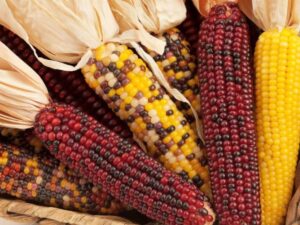
As we gather with family for Thanksgiving feasts this week, it will be especially poignant, as for many families (like my own), this is the first live Thanksgiving dinner in two very long years.
Most likely a turkey will occupy a place of honor in your feast; for me, the reveal of the roasted turkey on a platter is the singular moment of the day. For those with classic American tastes, the gobbler will be surrounded by mashed potatoes, stuffing, gravy, candied yams, cranberry sauce, pumpkin pie, and so much more. (My Italian-American friend grew up with a Thanksgiving dinner of Italian wedding soup, lasagna, and only THEN the full turkey dinner– wow.)
As we gather on this historic day, let’s pause for a short history lesson that answers a question historians have been arguing about for decades: just what did the Pilgrims eat on that first Thanksgiving back in 1621? The answer might surprise you.
Remember, the first Thanksgiving was a celebration of one year of the Pilgrims surviving the foreign New World landscape of eastern Massachusetts, plus a celebration of their first harvest, and the Wampanoag Indians graciously shared the feast with them– over three very long days.
So first, what they didn’t eat on that day: mashed potatoes, candied yams, pumpkin pie, and cranberry sauce. Since white potatoes originated in South America and their close cousin the sweet potato is Caribbean in origin, neither had yet spread to North America, and both would have been absent in 1621. Pumpkins are American fruit, and the Wampanoag likely taught the Pilgrims how to roast them in the fire, filling their insides with other vegetables, but there was no pumpkin pie; the Pilgrims lacked flour and butter, so no pie.
And while cranberries are a key crop in Massachusetts even today and the Pilgrims were surrounded by them, the recipe for cranberry sauce is more than 50 years in the future, as the Pilgrims lacked a key ingredient here too—sugar was incredibly scarce. So they ate dried or raw cranberries.
Without cranberry sauce, yams, and mashed potatoes, Kathleen Wall, historian and food culinarian at the Plimoth Plantation, told Smithsonian magazine in 2011, “That is a blank in the table, for an English eye. So what are they putting on instead? I think meat, meat, and more meat.”
So turkeys, right? While wild turkeys are, despite their name, a distinctly American bird—Ben Franklin famously thought it would be a better national symbol than the eagle—and while turkeys certainly inhabited the area where Pilgrims dined with their Wampanoag guests, turkeys were likely not on the table that first Thanksgiving, as there are reliable diaries and eyewitness accounts of the event at the time, with mention of lots of foods but– what!?– no mention of turkey.
We know venison was one huge component of the first Thanksgiving. In fact, records indicate Wampanoag hunters brought five deer to the feast, their contribution to the celebration.
“Wildfowl was there,” continued Wall, and she suspects goose or duck were at the center of the table—though she also discovered in her research that swan and passenger pigeons would have been available too. “Passenger pigeons—extinct in the wild for over a century now—were so thick in the 1620s, they said you could hear them a quarter-hour before you saw them,” she told the magazine. “They say a man could shoot at the birds in flight and bring down 200.”
And some of the birds were boiled first, then finished in the fire. Boiled passenger pigeon? Yikes. In addition to wildfowl and deer, the group probably feasted on eels and shellfish like lobster, clams, and mussels, all staples of the coastal Wampanoag. “They were drying shellfish and smoking other sorts of fish,” says Wall.
Wait, so lobster may have been present at the first Thanksgiving! (Perhaps we begin a new tradition?)
Wall thinks it is possible the birds were stuffed, just not with the same bread as today. Instead, the Pilgrims stuffed the geese with onion and herbs, and “there is a wonderful stuffing for goose in the 17th-century that is just shelled chestnuts,” says Wall. There was bread present, but made from maize and not wheat. Multi-colored Indian corn was a staple, ground not only for bread but for porridge too.
Like all eastern woodlands people, the Wampanoag, had a “varied and extremely good diet,” says Wall. The forest provided chestnuts, walnuts and beechnuts, and those would have been incorporated into that 1621 feast.
Of course, the modern Thanksgiving feast features too many desserts—I’m looking forward to our friend’s annual pecan-and-chocolate Derby pie. But the 1621 feast contained neither pies nor cakes; melons and grapes, available and seasonal, likely would have finished the meal.
And to wash it down? Wall thinks they simply drank water; beer and wine was not there.
The turkey-centric meal is more a product of the 19th than the 17th century, but the first event did feature two very different people speaking very different languages sharing food and creating community– not a bad model for the day that evolves into Thanksgiving.
Happy Thanksgiving, Roxborough.
By Mike Weilbacher, Executive Director
